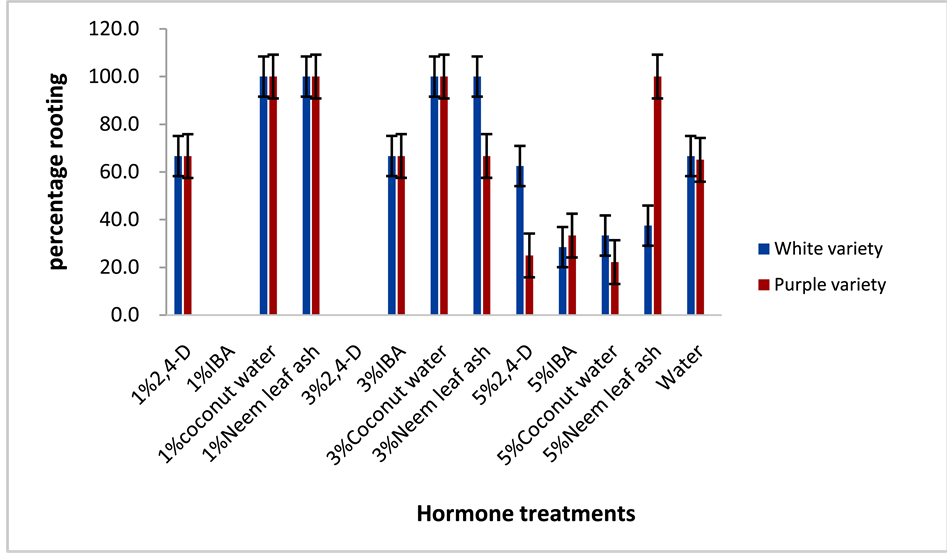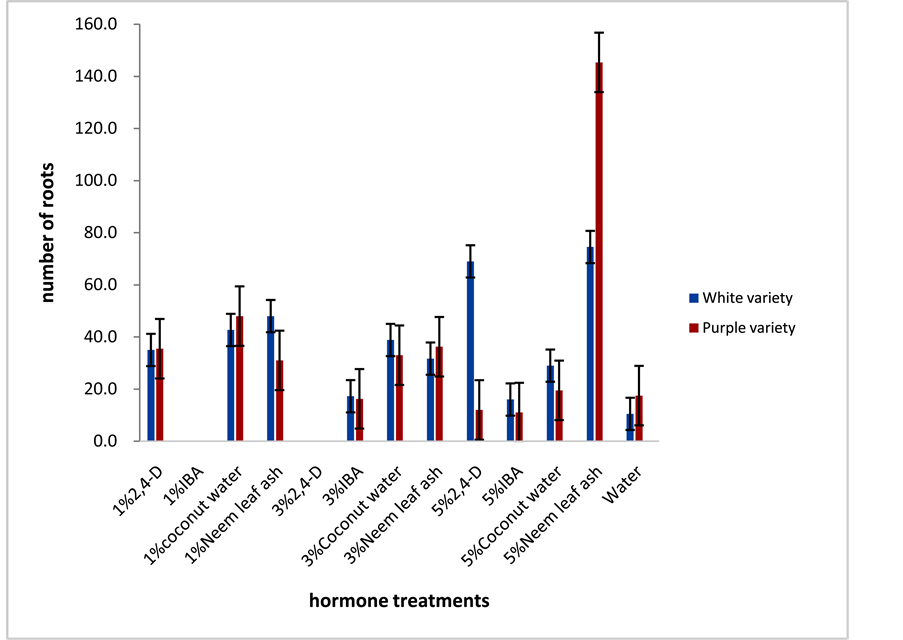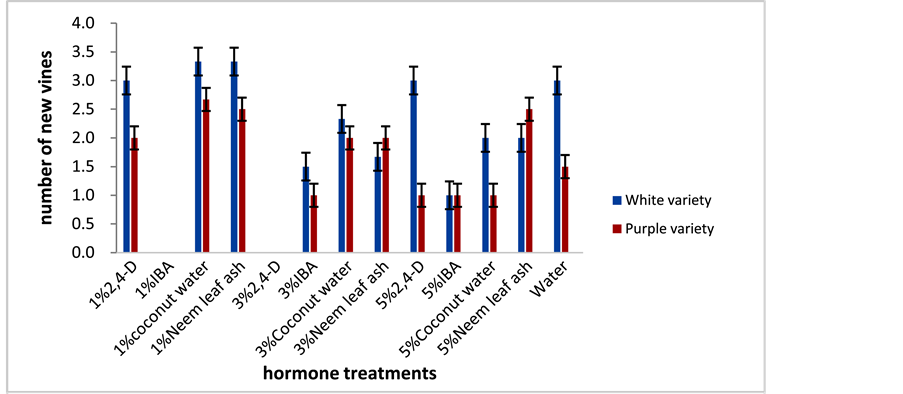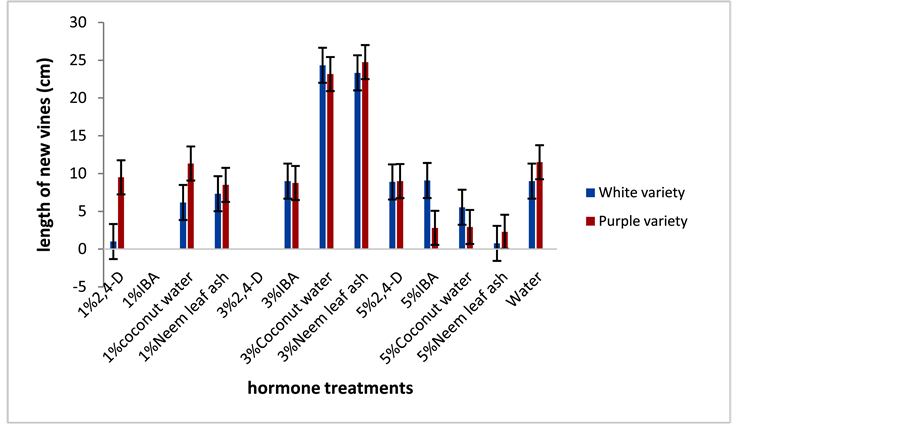American Journal of Plant Sciences
Vol.07 No.09(2016), Article ID:68679,8 pages
10.4236/ajps.2016.79130
Effect of Synthetic Hormone Substitutes on Rooting of Vine Cuttings in Water Yam (Dioscorea alata L.)
Edak A. Uyoh*, Effiom E. Ita, Mercy Essien, Ekeme Abasi F. Ewona, Mary Binang
Department of Genetics and Biotechnology, University of Calabar, Calabar, Nigeria

Copyright © 2016 by authors and Scientific Research Publishing Inc.
This work is licensed under the Creative Commons Attribution International License (CC BY).
http://creativecommons.org/licenses/by/4.0/



Received 10 June 2016; accepted 17 July 2016; published 20 July 2016
ABSTRACT
The use of yam vine cuttings as propagules with appropriate synthetic rooting hormones such as IBA (Indole-Butyric Acid) and NAA (Naphthalene Acetic Acid) has previously been reported as successful but expensive. To source for cheaper alternatives, this study compared the effect of some natural and synthetic hormones on rooting of vine cuttings in two varieties of Dioscorea alata. Vine cuttings from three months old water yam varieties were treated separately with 1%, 3% and 5% concentrations of each of the following: neem leaf ash, coconut water, 2,4-D and IBA with water as control. Treated cuttings were planted in triplicates in polythene bags using the completely randomised design and watered once in two days for 49 days. Data collected on rooting percentage, number of roots per plant, mean root length, number and length of new vines were subjected to analysis of variance tests and the means separated using least significant difference tests. A 100% rooting was observed in vines treated with 1% or 3% coconut water and neem ash. These vines also generated significantly greater number of new vines (P < 0.05) compared to those from synthetic hormones. Vines treated with 5% neem produced the highest number of roots (145.33 ± 9.21; P < 0.001) while those treated with 3% neem produced the longest roots (45.3 ± 9.23 cm) followed by those treated with 3% coconut water (24.3 ± 3.48). The study reveals that neem leaf ash and coconut water are better root promoting agents for water yam vines than 2,4-D and IBA and could be tested further for use as natural hormonal substitutes to the synthetic hormones.
Keywords:
Root-Promoting Agents, Dioscorea alata, Vine Cuttings, Neem Leaf Ash, Coconut Water

1. Introduction
Yam (Dioscorea spp. L.) is an economically important food crop in many tropical countries in West Africa, Central Africa and the Caribbean. It is a multiple species of the Dioscoreceae family that produces edible tubers of varied shapes and is propagated vegetatively or sexually through seeds in the tropics and subtropics. Over 90% of world yam production occurs in the yam belt of West and Central Africa with Nigeria alone accounting for about 68% of the world’s total [1] . Of the 600 known species of the genus Dioscorea, the most important edible species are D. rotundata (white yam), D. alata (water yam), D. cayanensis (yellow yam), D. dumetorum (bitter yam), D. esculenta (Chinese yam) and D. bulbifera (aerial yam). Among these, D. alata has been reported to be the most widely distributed globally [2] and is highly valued as food and for the starch that can be processed from it.
Up till today, the traditional and most widely practiced methods of growing yams involve the use of tubers or bulbils in which one of the following methods is used: 1) double harvest or milking or pricking, a system in which the same plant of an early maturing variety is harvested twice by first opening the mound from one side and detaching the tuber from the base of the vine while keeping most of the roots intact and the mound re- moulded; 2) “Anambra system” in which small tuber pieces of 80 - 100 g are cut from post-dormant “mother” tubers weighing 500 - 1000 g and planted to produce seed yams; 3) cut setts in which setts obtained by cutting large ware size tuber into tops, middles and bottoms each weighing 200 - 500 g are planted when the cut surfaces are dry; 4) small whole tubers sorted from a ware crop are reserved for planting [3] . In all of these methods, whole tubers or large pieces of 200 g or more of yams are usually employed for propagation [3] [4] . In most parts of Nigeria, up to 30% (3 - 5 t/ha) of the previous harvest may be used to plant new crops. This means that some remarkable quantity from each harvest, which could have been available for consumption, must be reserved for planting in the next cropping season. Thus other methods of yam propagation which do not require the use of large quantity of tubers or any tuber at all become desirable. Consequently, modern methods such as minisett and micropropagation techniques as well as the use of vine cuttings for seed yam production have been sought after [3] . In the minisett technique, a mother seed yam of 500 - 1000 g is cut into 20 - 40 pieces of 25 g or less yam setts. The minisetts must necessarily possess a periderm and be treated with chemical protectants [5] . The micropropagation techniques, which involve the use of tissue culture for rapid multiplication of yam seedlings, are feasible but the technology is expensive and not readily available for the local farmers.
Propagation from vine cuttings was first reported in non-food yams [6] . Njoku [7] first drew attention to the possibility of raising plants of D. alata, D. rotundata, and D. dumetorum through vine cuttings as an alternative to propagation by tuber and in recent times, it has been extensively reported in various food yams [5] [8] - [11] . The use of vine cuttings as propagating materials offers hope of alternative planting material to the tuber otherwise needed as energy food source for animals and man [8] . In addition, seed tubers obtained from vine cuttings increase the multiplication of clones beyond levels possible through conventional use of tuber pieces. It also results in seed tubers that are free of nematodes and soil borne pathogens if a sterilized medium is used and thus offers potential for “cleaning up” the declining clones [3] . Furthermore, large quantities of minitubers that are appropriate for international exchange of germplasm can be produced using vine cuttings, as well as normal size tubers for production of ware yam, depending on the time of harvest of vines [3] .
Some work has been done on yam propagation using vine cuttings aided by auxins or rooting hormones such as Indolebutyric Acid (IBA) and Naphthalene Acetic Acid (NAA) [9] [10] [12] . The cost implication of using these synthetic hormones is high and the ease with which they are obtained is limited. Therefore, suitable and cheaper sources of natural root promoting substances that are readily available for use by local farmers are required. Thus, this research was designed with the aim of comparing the efficacy of locally sourced substances with synthetic hormones for the rooting of yam vine cuttings in two varieties of D. alata (white and purple).
2. Materials and Methods
2.1. Experimental Site and Materials
The study was conducted in the experimental farm behind the Department of Genetics and Biotechnology, University of Calabar, Calabar Nigeria. One, three and five grams of 2,4-Dichlorophenoxyacetic acid (2,4-D), Indole-butyric acid (IBA) and neem leaf ash were each dissolved separately in 100 ml of distilled water to give 1%, 3% and 5% solution respectively. Similarly, 1%, 3% and 5% concentrations of coconut water were prepared by adding 1 ml, 3 ml and 5 ml of coconut water to 99 ml, 97 ml and 95 ml of water respectively. The coconuts used were matured and dry from the same bunch on a tree.
2.2. Experimental Procedure
Two tubers each from the two water yam varieties (purple and white water yam), weighing about 100 g each were cut into 3. The cut surfaces were rubbed with wood ash, air-dried for about 6 hours and planted in the field on ridges. The plants were allowed to grow for three months with regular weeding when necessary. Healthy looking vines were then excised from each of the plants and transferred to the laboratory in moist and labelled polythene bags. The vines from the middle portion of the lateral branch were prepared into 3-node cuttings with about 4 leaves each (the base was cut in a slanting manner to increase the surface area for hormone treatment). The cut vines were soaked in the prepared 1%, 3% and 5% of the respective treatment solutions and allowed to stand for 24 hours (the cuttings were submerged up to the first node position). Treated vine cuttings were planted in triplicates in perforated polythene bags filled with soil whose components were analysed. The experiment was laid out in a completely randomised design with 3 replicates. The plants were watered once in two days and allowed to grow for 7 weeks.
Data were collected on number of roots per plant, length of roots, number of new vines and length of new vines for each treatment and subjected to analysis of variance (ANOVA) test using the software GenStat Discovery edition [13] . Differences among treatment means were separated using the Least Significant Difference (LSD) test.
3. Results
3.1. Effect of Hormones on Rooting Percentage
Vines from both water yam varieties treated with 1% and 3% coconut water as well as 1% neem leaf ash gave 100% rooting (Table 2). Similarly, vines from the white variety treated with 3% neem leaf ash and purple variety treated with 5% neem leaf ash also gave 100% rooting. On the other hand, vines of purple variety treated with 5% coconut water gave the least rooting % while vines from both varieties treated with 1% IBA and 3% 2,4-D did not root at all (Table 2, Figure 1).
Figure 1. Effect of hormones on rooting percentage of two varieties of D. alata.
3.2. Effect of Hormone Treatment on Number of Roots per Plant
Vines from the purple variety treated with 5% neem leaf ash had the highest mean number of roots per plant (145.33 ± 9.21) while white variety treated with water had the least (10.50 ± 1.50) (Table 2, Figure 2). Analysis of variance (ANOVA) showed no significant differences (P > 0.05) between the means of the two varieties of water yam. However, very highly significant differences (P < 0.001) were obtained among hormone treatments in the number of roots produced (Table 2).
3.3. Effect of Hormone Treatment on Root Length
The white variety treated with 3% neem leaf ash had the highest (P < 0.01) mean length of roots (45.30 ± 9.20 cm) followed by purple variety treated with 3% neem leaf ash and white variety treated with 3% coconut water (28.75 ± 2.75 cm and 27.67 ± 1.20 cm respectively) while the purple variety treated with 5% IBA had the least length of roots (2.85 ± 0.06 cm), (Table 2, Figure 3).
3.4. Effect of Hormone Treatment on Number of New Vines per Plant
The mean numbers of new vines obtained in the two yam varieties are given in Table 2. The white variety produced significantly higher mean number of vines (2.38 ± 0.20) than the purple variety (1.74 ± 0.18). Plants treated with 1% coconut water and 1% neem leaf ash had the highest number of new vines for the white variety (3.33 ± 0.33) while 1% coconut water had the highest number of new vines for the purple variety (2.67 ± 0.67). On the other hand plants treated with 5% IBA in the white variety, 3% IBA, 5% 2,4-D, 5% IBA, and 5% coconut water in the purple variety, had least number of new vines (1.00 ± 0.00) (Table 2, Figure 4).
3.5. Effect of Hormone Treatment on Root Length
The purple variety treated with 3% neem leaf ash had the highest mean value (24.75 ± 3.25 cm) followed closely
Figure 2. Effect of hormones on number of roots per plant in two varieties of D. alata.
Figure 3. Effect of hormones on length of new roots per plant in two varieties of D. alata.
Figure 4. Effect of hormones on number of new vines per plant in two varieties of D. alata.
Table 1. Composition of soil used in planting.
ECEC = Effective Cation Exchange Capacity.
Table 2. Effect of hormone treatment on root and vine production in white and purple varieties of D. alata.
NS: not significant.
by white variety treated with 3% coconut water and 3% neem leaf ash (24.33 ± 3.48 and 23.33 ± 3.44 respectively), while the white variety treated with 1% 2,4-D had the least length of new vine (1.00 ± 0.00 cm), (Table 2, Figure 5). However, there was no significant difference in the mean length of the new vines produced by the two varieties (Table 2).
Result of soil analysis is as shown in Table 1.
4. Discussion
This study examined the effect of synthetic growth hormones (IBA and 2,4D) and natural sources of growth promoting substances (coconut water and Neem leaf ash) on the rooting of vines in 2 water yam varieties. The natural growth hormones (coconut water and neem) proved to be more effective than the synthetic hormones, from the results obtained. However, vine cuttings soaked in water (control) also rooted, (though at a lower rate) which indicates that the vines contained enough auxin levels to stimulate rooting.
The effectiveness of coconut water as root-promoting substance as observed in this study is not surprising because coconut water (10%) is one of the important components of basal medium supplements used in tissue culture for obtaining rooting and plantlet formation from immature yam seeds [14] . Its rich composition of sugar, amino acid, myo-inositol, and micro constituent (phenyl urea) has been well documented [14] [15] . Neem leaf ash has also been reported to promote rooting, increase number of roots and root length in cultivars of D. rotundata [11] . This further corroborates the findings in the present study.
The difference in plant growth between the two water yam varieties treated with coconut water, neem leaf ash, 2,4-D and IBA was not too glaring even though for production of new vines, the difference was significant statistically.
The number of roots in vine cutting is an important factor in determining the propagation capacity of cuttings and the quality of plants [16] . In the present study, copious amounts of roots were produced in all the vines ranging from a mean of about 10.70 to 145.33 (Table 2, Plate 1 ). Generally, vine cuttings treated with neem leaf ash and coconut water performed best in both white and purple varieties of D. alata studied. However, vine cuttings treated with 1% IBA and 3% 2,4-D in both varieties did not produce roots at all. This is at variance with earlier reports by Acha [9] [17] and [11] , who reported the production of appreciable number of roots from vine cuttings of different cultivars of D. rotundata treated with similar concentrations of IBA alongside with other synthetic hormones. The non-production of roots by vine cuttings treated with 1% IBA and 3% 2,4-D as observed in this study may seem to suggest that unlike other yam species, D. alata roots better in higher
Figure 5. Effect of hormones on length of new vines in two varieties of D. alata.
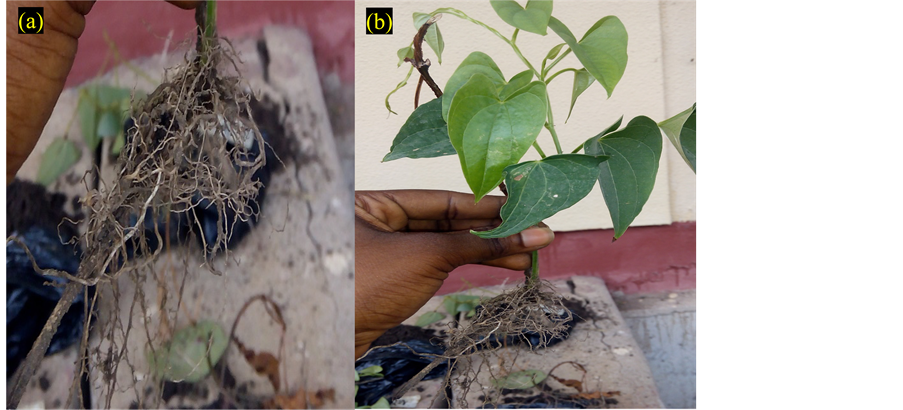
Plate 1. (a) Vine with copious roots; (b) New vines produced.
concentrations of IBA. Further investigations may be needed to clarify this issue as other concentrations of the same hormones produced roots as well as vines.
One of the major limiting factors militating against the use of vine cuttings for mini tuber generation is the poor establishment even after rooting. This problem has been tackled by several workers through the addition of carbonized rice husk in the planting media [5] [10] . This was not considered in the present study as the water yam vines were readily established in the phosphorus-rich, slightly acidic soil used as the planting medium whose composition is given in Table 1.
5. Conclusion
The study reveals that neem leaf ash and coconut water are better rooting agents than 2,4-D and IBA and could be tested further for use as natural hormonal substitutes to the synthetic hormones.
Conflict of Interest
The authors declare no conflict of interest.
Cite this paper
Edak A. Uyoh,Effiom E. Ita,Mercy Essien,Ekeme Abasi F. Ewona,Mary Binang, (2016) Effect of Synthetic Hormone Substitutes on Rooting of Vine Cuttings in Water Yam (Dioscorea alata L.). American Journal of Plant Sciences,07,1372-1379. doi: 10.4236/ajps.2016.79130
References
- 1. FAO (2014) FAOSTAT Database Online.
http://faostat.fao.org/ - 2. Mignouna, H.D., Abang, M.M. and Asiedu, R. (2007) Advances in Yam (Dioscores spp.) Genetics and Genomes. Proceedings of the 13th ISTRC Symposium, Amsha.
- 3. Aighewi, B.A., Asiedu, R., Maroya, N. and Balogun, M. (2015) Propagation Methods to Raise the Production of Yam (Dioscorea rotundata Poir). Food Security, 7, 823-834.
http://dx.doi.org/10.1007/s12571-015-0481-6 - 4. Okonkwo, S.N.C. (1985) The Botany of the Yam Plant and Its Exploitation in Enhanced Productivity of the Crop. In: Osuji, G., Ed., Advances in Yam Research: The Biochemistry and Technology of the Yam Tuber, Biochemical Society of Nigeria and Anambra State University of Technology, 3-29.
- 5. Otto, E., Anyakanmi, T.G., Kikuno, H. and Asiedu, R. (2016) In Vivo Yam (Dioscorea spp.) Vine Multiplication Technique; the Plausible Solution to Seed Yam Generation Menace. Journal of Agricultural Science, 8, 88-97.
http://dx.doi.org/10.5539/jas.v8n2p88 - 6. Correll, D.S., Schubert, B.G., Gentry, H.S. and Hawley, H.D. (1955) The Search for Plant Precursors of Cortisone. Society of Economic Botany, 9, 307-375.
http://dx.doi.org/10.1007/BF02985309 - 7. Njoku, E. (1963) The Propagation of Yams (Dioscorea spp.) by Vine Cutting. Journal of the West African Science Association, 8, 29-32.
- 8. Vander, Z.P. and Fox, R.L. (1981) Field Production of Yams (Dioscorea alata) from Stem Cuttings. Tropical Agriculture, 58, 143-145.
- 9. Acha, I.A., Shiwachi, H., Asiedu, R. and Akoroda, M.O. (2004) Effect of Auxins on Root Development in Yam (Dioscorea rotundata) Vine. Tropical Science, 44, 80-84.
http://dx.doi.org/10.1002/ts.140 - 10. Kikuno, H., Muamba, K., Shiwachi, H., Micho, O. and Asiedu, R. (2006) Minituber Production of Yam (D. rotundata) Using Vines. Japanese Journal of Tropical Agriculture, 50, 1-3.
- 11. Agele, S.O., Ayankanmi, T.G. and Kikuno, H. (2010) Effect of Synthetic Hormone Substitutes and Genotypes on Rooting and Minituber Production of Vines Cuttings Obtained from White Yam (Dioscorea rotundata). African Journal of Biotechnology, 9, 4714-4724.
- 12. Okoli, O.Q. and Akoroda, M.O. (1995) Providing Seed Tubers for the Production of Food Yams. Africa Journal of Root and Tuber Crops, 1, 1-6.
- 13. Genstat (2007) Genstat for Windows, Discovery. 3rd Edition, Lawes Agricultural Trust, Rothamsted Experimental Station, UK.
- 14. IITA (2000) International Institute for Tropical Agriculture Annual Report. Ibadan, Nigeria.
- 15. Komamine, A., Ojimah, K., Sankawa, V., Harada, H., Hinata, K., Fujimura, T. and Yamaguchi, H. (1990) Dictionary of Plant Biotechnology. Ashakura Shoten, Tokyo, 217-219.
- 16. Hartmann, H.T., Kester, D.E., Davies Jr., F.T. and Geneve, R.L. (2010) Plant Propagation: Principles and Practices. 8th Edition, Prentice-Hall, New Jersey, 915 p.
- 17. Acha, I.A. (2002) Sustainability of Yam (Dioscorea spp.) Clones for Rapid Multiplication: A Master of Science Project Thesis Submitted to the Department of Agronomy, Faculty of Agriculture and Forestry, University of Ibadan, 68.
NOTES
*Corresponding author.


